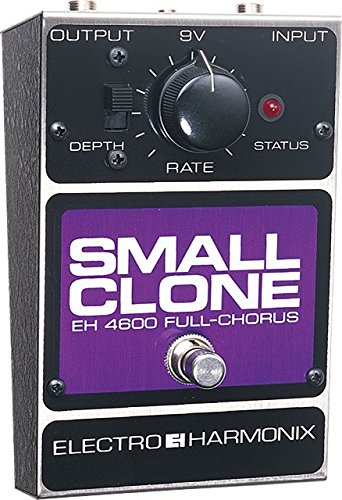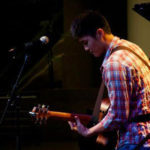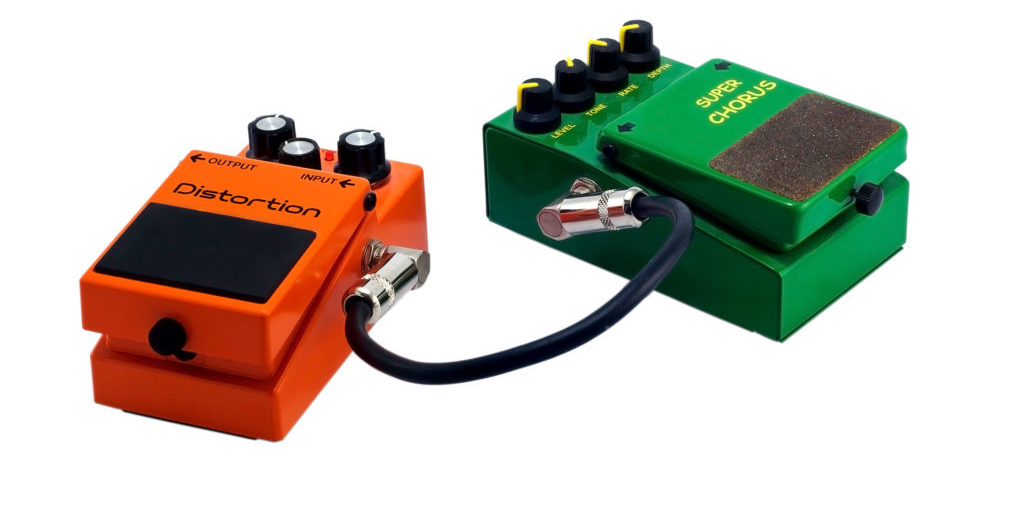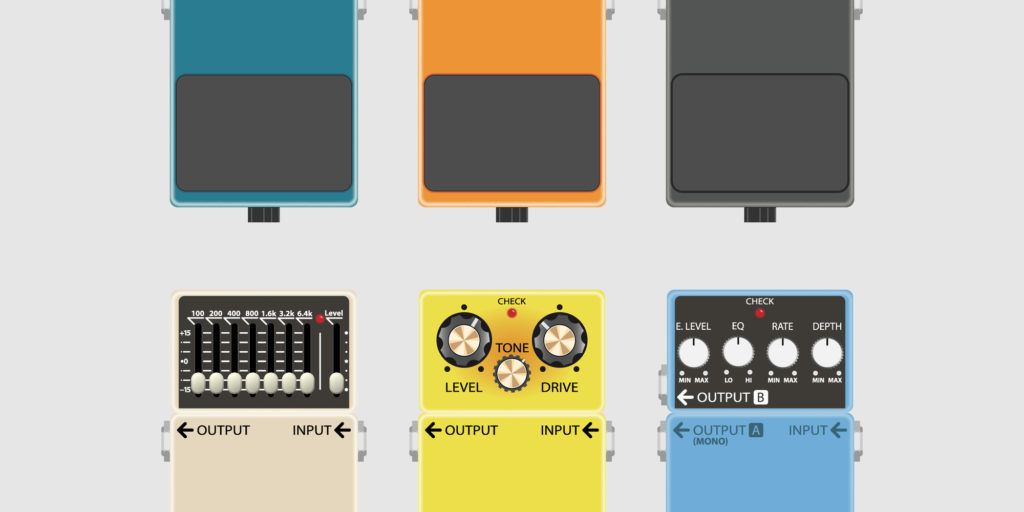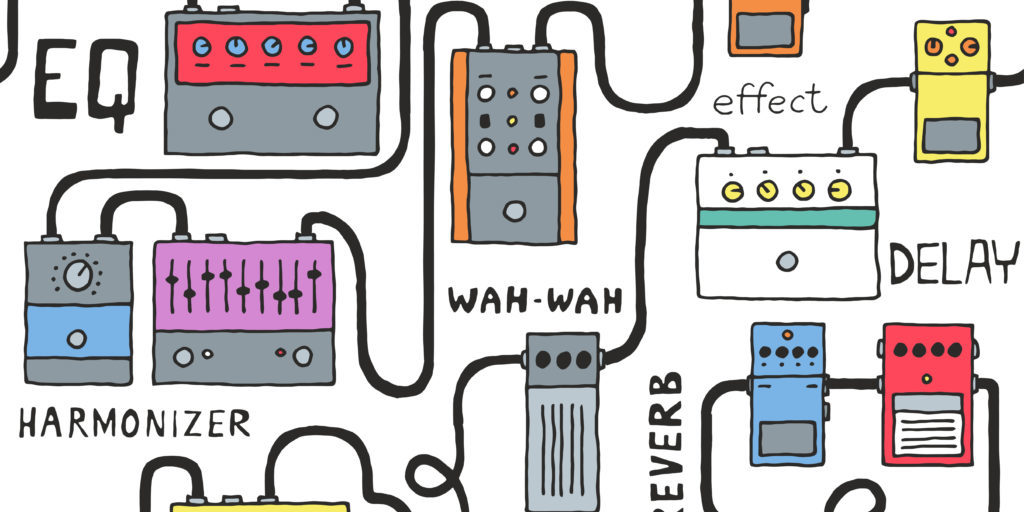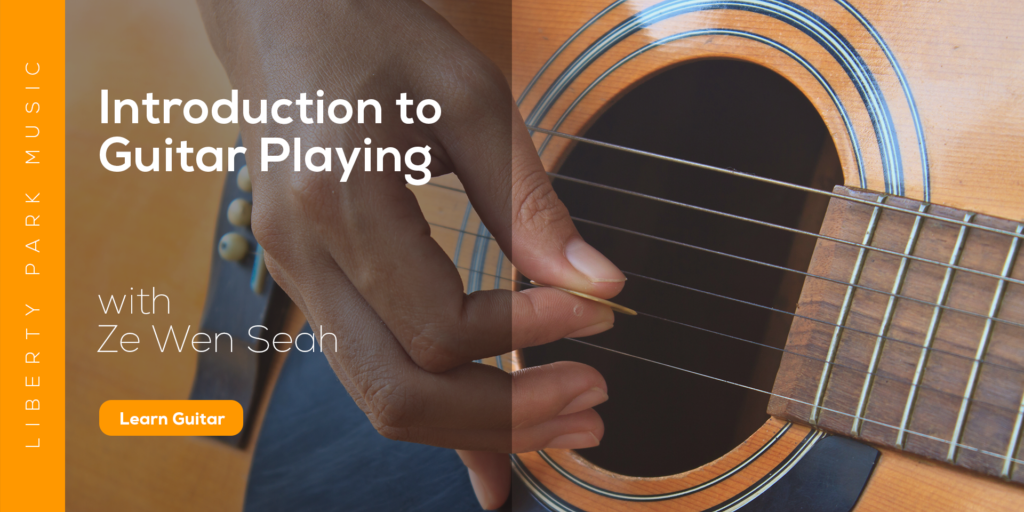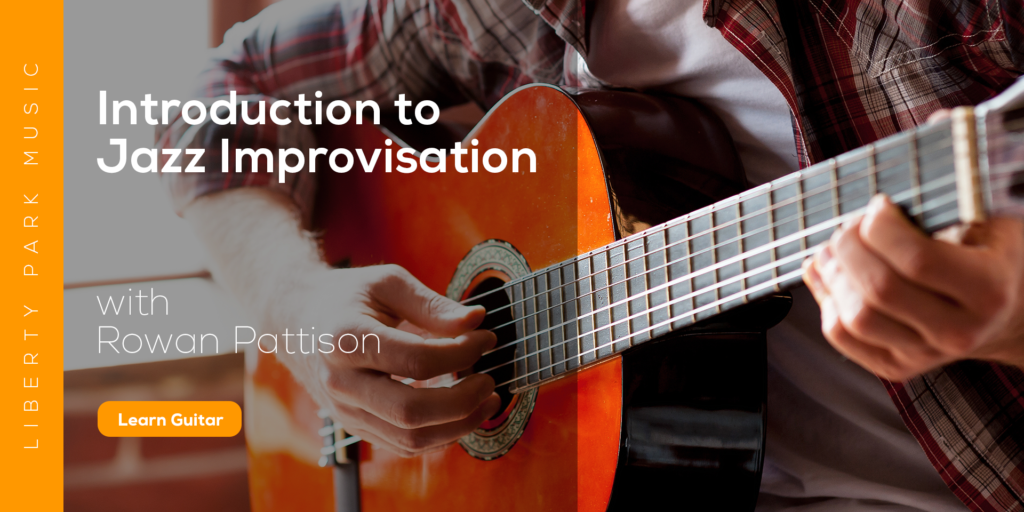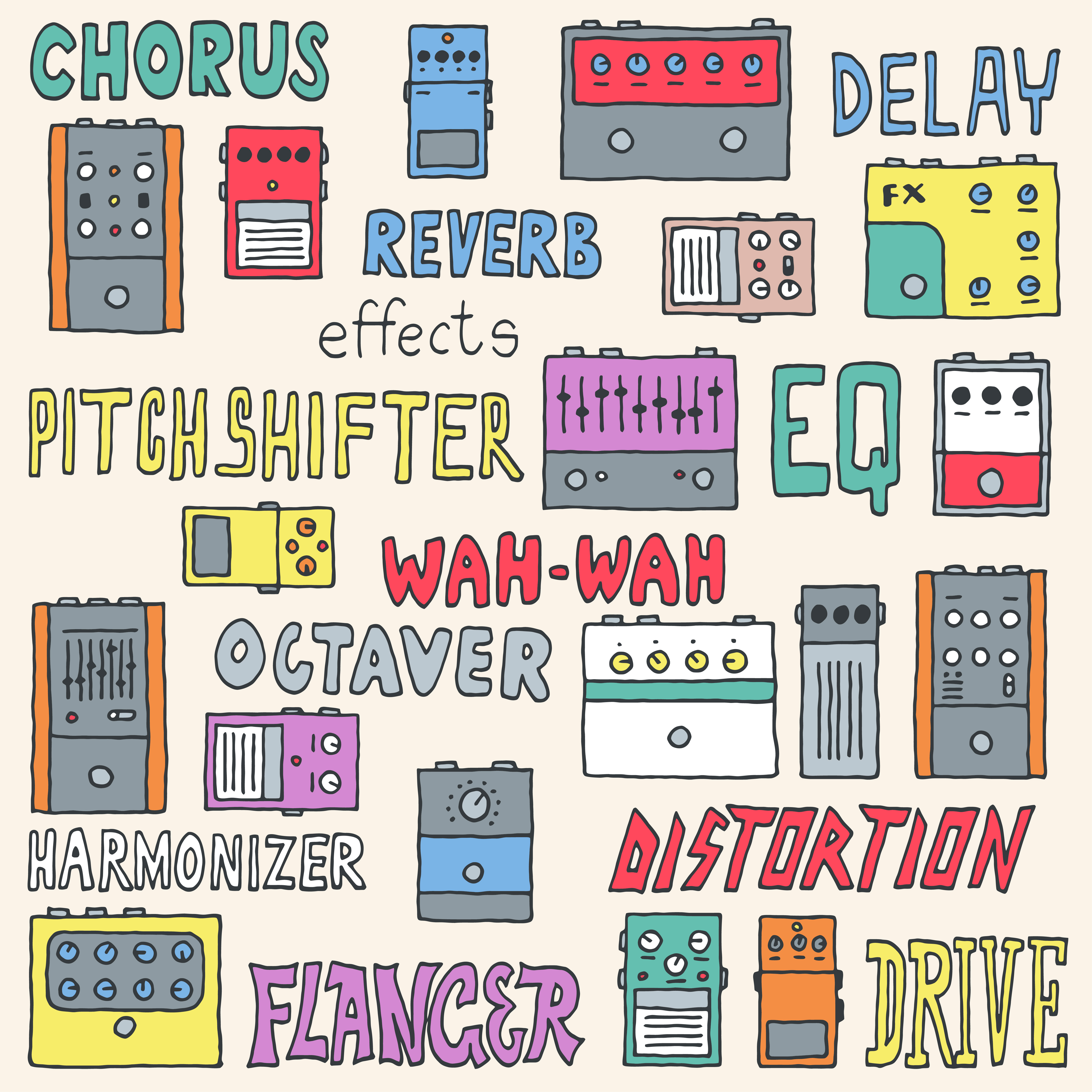
Chorus effects pedals create another class of modulation effects that people often confuse with flangers and phasers. Technically, a chorus effect is very similar to a flanger, just with a different sonic objective. While the chorus effect isn’t discussed as often as some of the more popular effects like overdrives or delays, it is actually a really important effect, especially if you play a lot of classic rock.
The goal of a chorus effect is to mimic the sound of a choir, hence the name. In a choir of human voices, there will always be slight variations of pitch and timing as human beings are not perfect musical machines. In order to achieve this same effect in a chorus pedal, the incoming signal is split into several different voices with added time and pitch variations. These are the three main adjustable parameters on chorus effects: Voices (how many times the signal is split), Delay (how much time delay the duplicated voices will have), and Pitch (how much do the voices vary in pitch).
Examples of a chorus effect include the opening riff of “Come As You Are” by Nirvana, “Walking On The Moon” by The Police, Nile Roger’s staccato funk guitar part in “Get Lucky” by Daft Punk, and “Just My Luck” by jazz-fusion guitarist John Scofield.
When you’re looking to buy a chorus pedal, there are only two things that you have to consider. The first is, do you want to go the analog or digital pedal route? The analog vs. digital debate has been going on for ages and both versions have benefits but, spend enough time on any guitar forum and you’ll often come out more confused than you were before. This is just a really controversial topic. However, I feel like analog chorus pedals (and all analog effects pedals) have a warmer tone compared to a brighter and clearer tone found in their digital counterparts. That’s not to say that all digital pedals are made to have a brighter tone and all analog pedals are made to have a warmer tone. There are exceptions out there. Another thing about analog vs. digital pedals is digital pedals tend to allow you to have more control over the sound. This might be important for those of you who just love tweaking your pedals until you find that perfect tone.
The second consideration when buying a chorus pedal is how the pedal is voiced. As I mentioned above, analog pedals tend to be voiced warmer while digital pedals tend to be brighter and clearer. While this may not always be the case (as there are warm sounding digital pedals), you do have to consider how your chorus pedal is voiced because simply slapping a chorus effect on to your current signal chain can cause problems if the tone is not matched correctly. Let’s say for example, your current rig gives you a really warm and round tone. If that’s what you have already, you definitely want to avoid a warm sounding chorus pedal as that can really muddy up your overall sound. Remember that chorus pedals basically work by duplicating your signal, so imagine a warm tone being replicated over and over again in a warmly voiced chorus pedal. Your tone will sound like there’s a blanket over your speaker. Inversely, the same can be said with a generally bright tone being matched with a brightly voiced chorus pedal. It will sound like ice picks in your ears.
Once you’ve gotten an idea of the sound you’re going for, and more importantly, what kind of budget you have, feel free to continue reading our list of some of the most popular chorus pedals currently on the market.
1. TC Electronic Corona Stereo Chorus
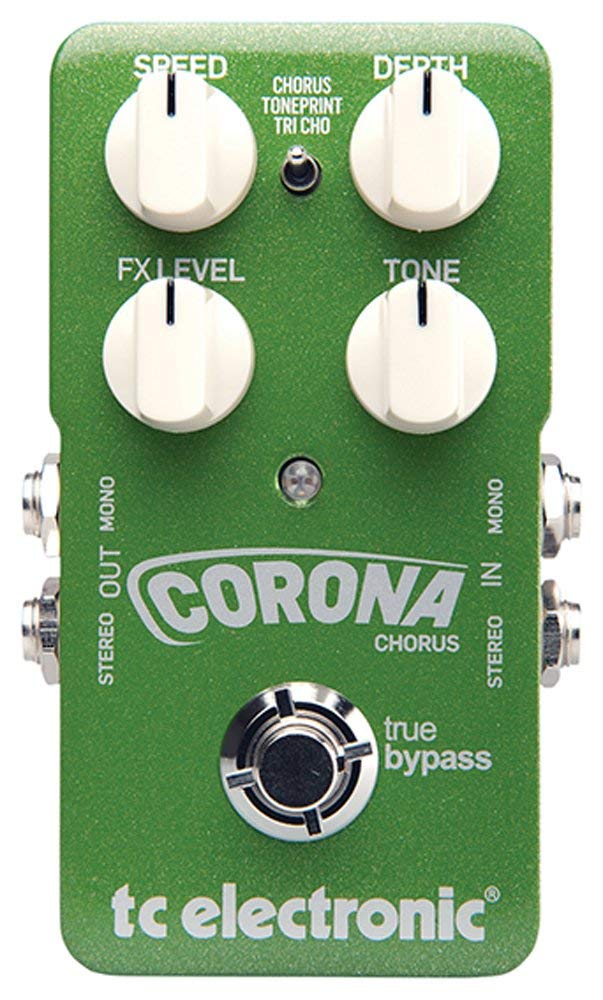
Brand New: $99
Used: $60 - $75
Let’s begin with a pedal from Danish manufacturer, TC Electronic. This company is one of my favorite effects pedal companies due to their use of high-quality components, great sounding pedals, and the super cool TonePrint technology. We’ll discuss a little more about TonePrint in a bit.
The TC Electronic Corona is a great sounding digital chorus pedal that’s actually more like three pedals in one. With the mode switch that sits right in the middle of the pedal, you have three different operating modes to select: Chorus, TonePrint, and Tri-Chorus. In Chorus mode, the pedal behaves like a regular chorus effect. The tone of the chorus effect can be adjusted by the four knobs present on the face of the device: Speed, Depth, FX Level, and Tone. The Speed knob adjusts the speed of the oscillating sound that is present in all chorus effects. You can think of it like adjusting the speed of a singer’s vibrato. The Depth knob makes the effect a little more obvious by increasing the pitch variation in the different voices. The FX Level is a really helpful knob that allows you to adjust the volume of the effect. This will allow you to have the option of having a really subtle, and barely noticeable, chorus, or a super obvious and wide sounding chorus. The Tone knob works like an EQ, making your tone brighter and more pronounced when turned clockwise, and darker and warmer when turned counter-clockwise.
In TonePrint mode, the pedal allows you to cast specific tone settings that can be found online into your pedal. TC Electronic has a huge library of different TonePrints, even providing some that were made by renowned artists. The way TonePrint works is really cool and you can check out a demo of it in this video. The addition of TonePrint essentially gives you the option of thousands of various sounding chorus effects, which is why it is such a popular feature.
Finally, the Tri-Chorus mode layers three different voicings which results in a shimmering effect that’s really lush sounding.
This pedal is true bypass, but has an optional buffered bypass to preserve tonal integrity when using long cables. The pedal has stereo inputs and outputs (great for chorus effects), and it can be powered with a 9v battery or power adapter. There is also a mini version of the Corona with the same great sound, but it does lack a few parameter knobs.
Considering the number of features that come with this pedal, and the really affordable price tag, it’s no mystery as to why it is one of the most popular chorus pedals currently on the market.
Notable users of this pedal include John Petrucci and Joe Perry.
Buy here
2. Electro-Harmonix Small Clone
Brand New: $109.99
Used: $45 - $60
Here is a chorus pedal that really gained popularity thanks to its appearance on Kurt Cobain’s pedalboard. If you’re looking for a really simple and great sounding chorus pedal, then you can’t go wrong with the EHX Small Clone. Besides its appearance on many Nirvana tunes, this pedal can also be heard being used by many popular bands in the 80’s and 90’s. The all-analog circuitry found inside the pedal guarantees a warm and lush sounding chorus effect, and with the addition of true bypass in the modern reissue models, your tone will stay the same when the pedal is turned off.
One of the most attractive features of this pedal is how easy it is to use. Only two controls can be found on this device -- a large knob labeled “Rate,” and a switch labeled “Depth.” The Rate knob is the same thing as a Speed parameter, and the Depth switch has two options. Push the switch down, and the effect is much more subtle; push the switch up, and the effect is a lot more obvious.
While this pedal is truly a classic, it does have its problems. The first issue that some people have faced is the persistence of noise being generated by the pedal. That can get really annoying, and in order to get rid of it, you will have to use a noise gate. Another annoying thing about this pedal is that if you’re planning on using a 9v power adapter to power the device, it doesn’t accept your regular 9v DC adapter plug. Instead, it uses this specific power adapter. Having to use a different power adapter can be frustrating for those of you who power your guitar pedals using your typical pedal power supply. Of course, you can always power the pedal with a 9v battery instead. The last potential issue is that while the simplistic nature of this pedal is one of its strong points, it can also be a huge limiting factor for those of you who like to tweak your sound.
Overall though, the pedal sounds great despite its low cost and that’s probably why it can be found on the pedalboards of many touring pros.
Buy here
3. Dunlop MXR Micro Chorus
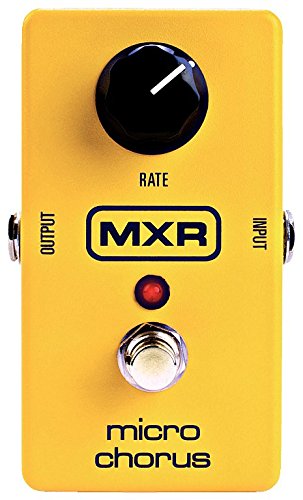
Brand New: $90
Used: $40 - $55
Since we’re on the topic of simple-to-use pedals, here’s an even more user-friendly pedal from MXR. Right off the bat, you’ll notice that this pedal looks like it only has a single knob labeled “Rate.” However, don’t let the lack of controls fool you, the various sounds you can get from adjusting just one knob on the Micro Chorus is quite impressive.
The tones that you can get from this pedal range from subtle flutters to lush and full swirls of madness. This pedal also has full analog circuitry, so you can expect really warm and pleasant sounds regardless of where the Rate knob is set. The housing of this device also looks and feels pretty sturdy, so you can expect it to work even after taking a beating. Another thing to mention about the housing is that it’s pretty compact, relative to the other pedals on this list. It’s about the size of the iconic MXR Phase 90, so you’ll have no problems finding a space for this device on your pedalboard.
Of course, there are many limitations to using a pedal with only a single knob, but sometimes having a limited number of tweakable parameters can help you get into a creative mood a lot faster.
The pedal comes with true bypass, and it can be powered with a 9v battery or adapter. If you’re looking to play around with a great chorus sound without breaking the bank or your brain (from tweaking all those knobs), then the Micro Chorus is definitely something you should check out.
Buy here
Learn with LPM
If you are looking to feel comfortable with playing basic major and minor chords, power chords, and apply different strumming techniques to your practices with Ze, check out his course called Rhythm Guitar
4. MXR M134 Stereo Chorus
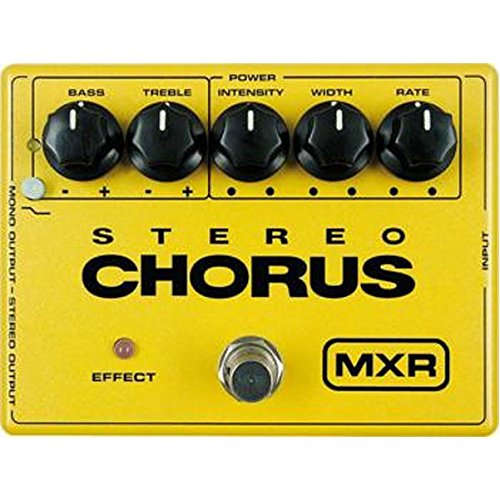
Brand New: $170
Used: $80 - $105
The MXR Stereo Chorus is the big brother of the Micro Chorus. While the Micro Chorus only has a single knob, the Stereo Chorus has five! You’ll also see a noticeable size difference between the Stereo Chorus and Micro Chorus, and the Stereo Chorus is in fact one of the biggest pedals featured on this list. However, what remains the same between these two pedals is the fantastic chorus sound produced by an analog circuitry.
The five knobs on the pedal are split into two sections -- an EQ section and the chorus section. In the chorus section, there are three knobs labeled “Rate,” “Width,” and “Intensity.” As we know by now, Rate controls the speed of the oscillating sound, and Intensity works the same way a Depth knob works. Width allows you to control the sweep range of the chorusing effect. The EQ section has a knob for Bass and Treble. These two knobs will allow you to sculpt the bass and treble frequencies of the chorus tone, which gives you quite a bit of versatility. A good way to use the EQ section is to set it up in a manner where it contrasts your clean tone. Additionally, there is also a small white switch that’s a bass filter for the chorusing effect. What that means is only the notes played above a certain bass frequency will have the chorus effect applied. This is a great addition as applying a chorus on lower frequency notes can cause your tone to sound really muddy.
As the name implies, this pedal has stereo outputs, which many people swear to be the only way to use a chorus effect. When using a stereo output, the chorus effect sounds larger and much more like a choir in front of you. Of course, the pedal can also be used as a mono pedal if you wish to do so.
This pedal features true bypass and it can be powered with two 9v batteries or an 18v power adapter.
Buy here
5. Strymon Ola
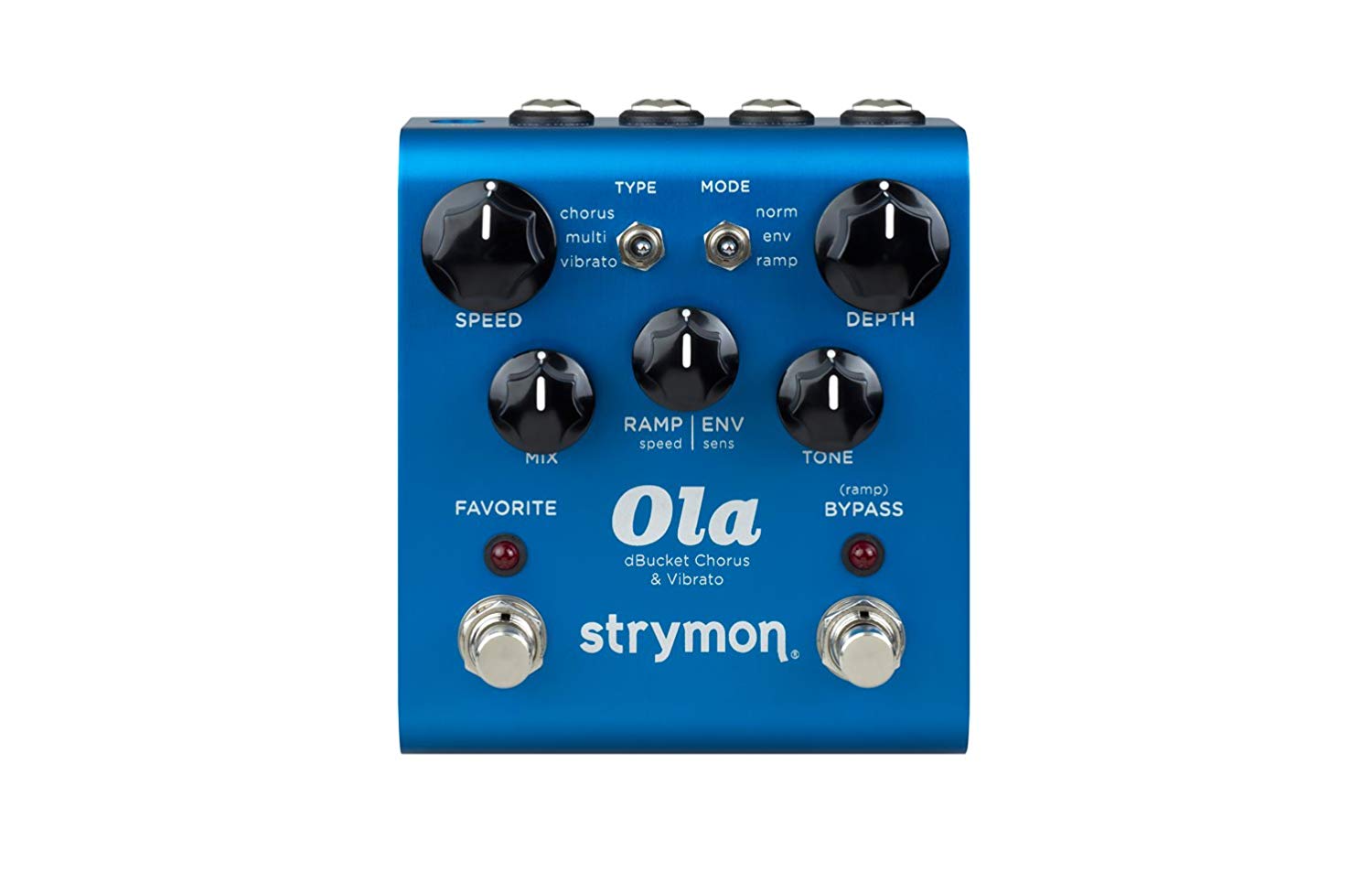
Brand New: $299
Used: $205 - $245
Strymon first opened its doors for business in 2008 and since then, the company has made a name for itself by creating high quality, made in the USA products that sound amazing. Some people have even started using Strymon effects pedals in recording studios in lieu of studio-grade rack-mounted effects. While many people use Strymon pedals mainly as a guitar effect, most of the pedals on the Strymon product-line can be used with a variety of instruments, in a variety of contexts. They’re just that good.
The Strymon Ola is another stellar sounding pedal from the Californian builder. However, as you’d expect from a high quality device, it comes at quite a hefty cost. In fact, the Ola is the most expensive pedal featured on this list, coming in at almost twice the cost of the MXR Stereo Chorus. It could be argued though, that the Ola is also almost twice as tweakable as the MXR Stereo Chorus, so if you’re the kind of person that loves spending time tweaking your sounds, you will love this pedal.
The number of different sounds you can get from this pedal is limitless, and dialing in a tone can be done using a host of knobs and switches found on the front panel of the device. The four main knobs labeled Speed, Depth, Mix, and Tone allow you to quickly dial in a sound when the pedal is set to normal mode. Speed, Depth, and Tone behave in the same way on the Strymon Ola as on the other pedals on this list, and Mix allows you to set the mix between a clean (dry) and wet (effected) signal. This will allow you to dial in a really warbly chorus sound, while still giving you the option to make it sound really subtle by bringing the mix of the wet signal down.
There are two switches that allow you to further adjust your chorus sound. One is labeled Type and the other is labeled Mode. The Type switch allows you to choose between three different sound modes: Chorus, Multi, and Vibrato. When switched to Chorus mode, you will get your traditional single delay-line chorus sound. In Multi mode, you will have a studio-grade three-phase multi delay-line chorus sound. In Vibrato mode, you will get a vintage vibrato sound. As you can see, you’re essentially getting three different pedals from the Strymon Ola.
The Mode switch allows you to use the pedal in very unique ways. The three settings for the Mode switch are Normal, Env, and Ramp. In Normal mode, the Ola behaves as a regular chorus pedal that can be switched on and off using the bypass footswitch. In Env (envelope control) mode, the chorus effect is sensitive to the volume of your playing. Depending on where your Type switch is positioned, playing your guitar louder may produce a much more obvious chorus sound compared to playing your guitar quietly. How sensitively the pedal reacts to your playing can be adjusted using the knob in the middle labeled Ramp/Env. When the mode switch is set to Ramp, holding down the bypass switch will cause the effect to ramp in, instead of having your typical on/off behaviour. How fast the effect ramps in can be adjusted using the Ramp/Env knob.
One great feature of the Ola is the addition of a favorite switch. The addition of this switch allows you to save your favorite chorus sound by simply holding down on the favorite switch for a few seconds. Recalling the sound after it saved is simply done by clicking on the the favorite switch.
This pedal has stereo inputs and outputs, but can also be used as a mono pedal. In addition, it features true-bypass and it can be powered with a 9v battery or power adapter.
Buy here
6. DigiTech Luxe
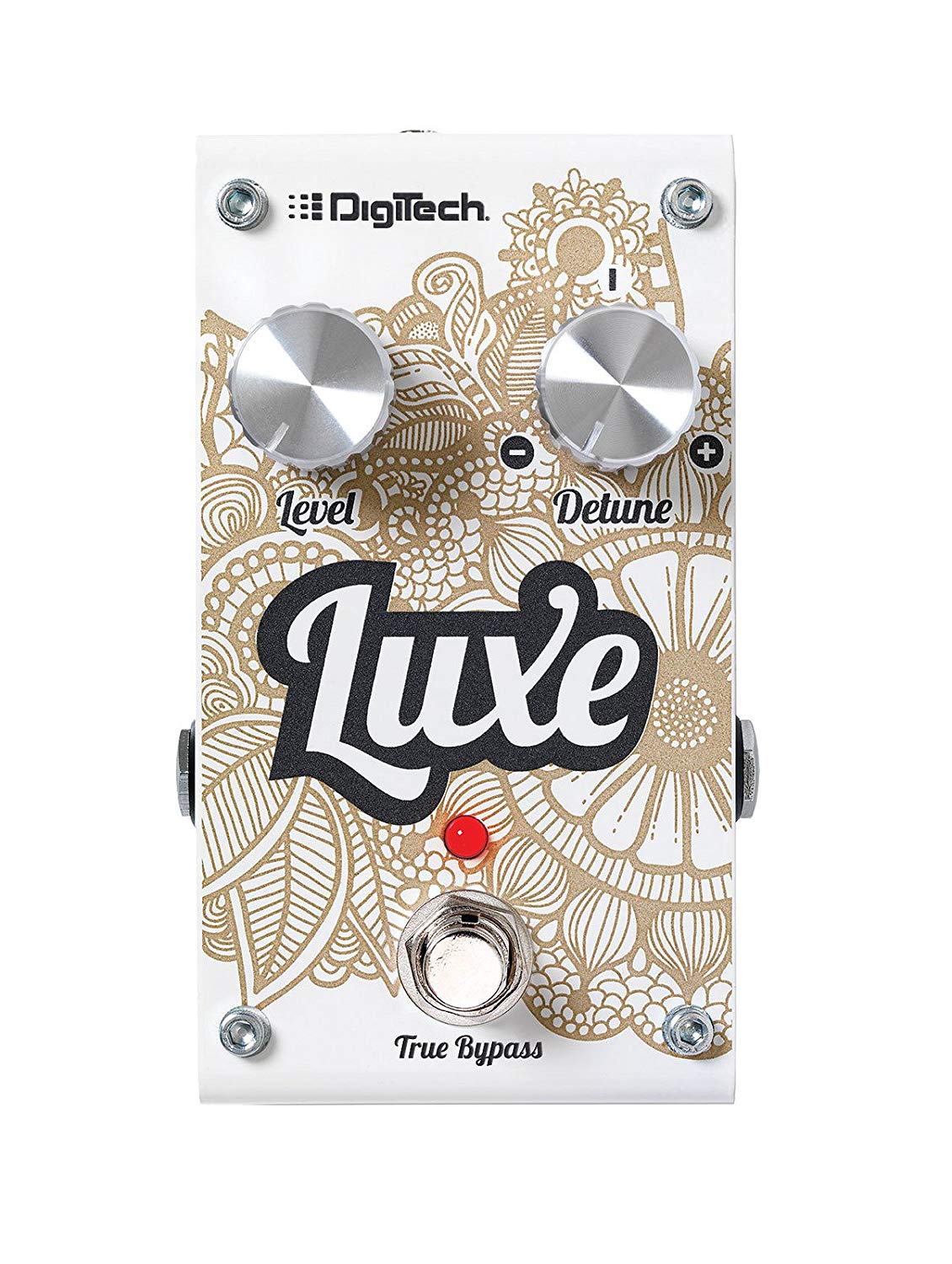
Brand New: $49.99
Used: $35 - $40
The DigiTech Luxe is a little bit of an odd one out on this list. First of all, it technically isn’t a chorus pedal (as hinted by its nickname, the anti-chorus). While chorus pedals use LFO (low frequency oscillator) modulation to achieve that iconic chorus sound, the Luxe achieves a similar effect by using polyphonic pitch-detuning. Basically, it doubles the guitar signal and changes the pitch of the notes played. This results in a thickening, chorus-like sound, but without the rotating oscillation sounds. Another trait that sets this pedal apart from the others on this list is the price. At $49.99, this pedal is the cheapest one featured on this list, and it’s also one of the easiest to use.
On the face of the pedal, you will only find two knobs. The Level knob lets you dial in how much of the effect you’d like in your signal and the Detune knob adjusts the level of the effect. The range of detuning goes from -50 to +50 cents. When compared to an actual chorus effect, the Luxe actually sounds very similar, and one of the advantages it has over the other chorus effects is how easy it is to use the Luxe.
The Luxe features true-bypass to retain your clean tone, and it can be powered by either a 9v battery or power supply. DigiTech also provides a power supply for the pedal, which will be appreciated by many of their customers.
Buy here
7. BOSS CE-5 Chorus Ensemble
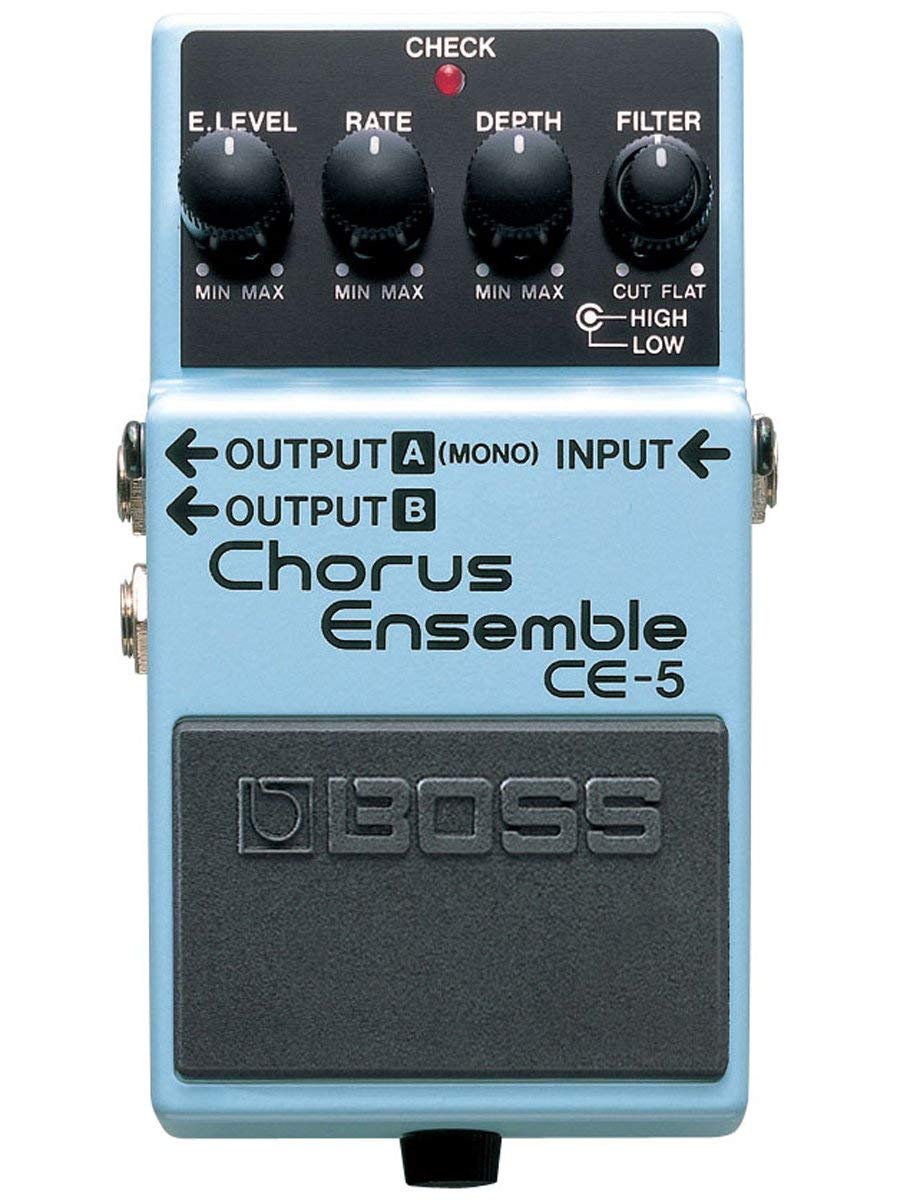
Brand New: $109.99
New: $40 - $60
It’s hard to create any guitar effects pedal list without the inclusion of a BOSS pedal. For decades, BOSS has been known to produce very sturdy and good sounding guitar effects pedals, and the CE-5 is no different.
This pedal comes in the typical rugged BOSS enclosure that we’ve come to know and love. It’s sturdy, chunky, and looks like it can take a direct hit from a sledgehammer. If you own any other BOSS pedal, then you know what I mean when I say these things are durable. In terms of features, the CE-5 is a pretty straightforward chorus pedal. It comes with four adjustable parameters: E. Level (Effects Level), Rate, Depth, and Filter. While E. Level, Rate, and Depth are pretty self-explanatory at this point, the Filter (which is just an EQ) parameter is a little unique. If you look closely, the Filter knob is actually two knobs stacked together. The knob above controls a filter for the high frequencies and the knob below is for the low frequencies. This combination of two knobs allows you more flexibility in sculpting the sound of your chorus, which is a great feature to have at this price.
While the CE-5 does have stereo outputs, it only has a mono input. This may not be a big deal to be honest, but it’s something you should consider. Additionally, the CE-5 does not have true bypass. In fact, none of the BOSS pedals (as far as I know) have true bypass, which is something that has always puzzled me as I do believe that BOSS pedals have an effect on your clean tone. I’ve actually replaced a BOSS looper pedal with another brand’s looper pedal because of this exact issue. However, the buffered bypass found in BOSS pedals aren’t terrible, and I’ve definitely come across worse.
This pedal can be powered using a 9v battery or power adapter.
As you can see, the BOSS CE-5 and TC Electronic Corona are roughly at the same price point, which may leave you wondering which is a better fit for you. While they are both digital chorus pedals, they have pretty different sounds. Another thing to consider is the inclusion of a Tri-Chorus and TonePrint mode on the Corona. The Corona also has true bypass (with optional buffered bypass), which is something that BOSS should really consider doing. However, if you’re looking for something that can possibly outlive you, BOSS pedals have a stellar reputation for durability. There have been complaints about the footswitches in TC Electronic pedals as they tend to stop working after a couple of years. That will never be an issue with a BOSS pedal. This is why you will see many touring pros use BOSS pedals regardless of the flaws they may have. In fact, Steve Vai and Jerry Cantrell are notable users of the CE-5, and those guys tour a lot.
Buy here
There are definitely quite a number of other chorus pedals out there that may fit your needs, but these are some of the most popular ones that I’ve become familiar with myself. If you feel like there should be a pedal included on this list, please let us know in the comments!
About the Author: Ze
Ze first began his journey playing original music and top 40s pop tunes around the country's popular venues. Eventually, through the music of John Mayer, he found a strong attraction to blues music. Ze has years of experience teaching beginners and intermediate guitarists. Currently with Liberty Park Music he is teaching Introduction to Guitar Playing for Complete Beginners, Rhythm Guitar to learn about strumming, chords and more, Guitar Essentials as a fast-track review course, and lots of Song Lessons on pop and rock hits.

